Amazon UK Release Seller Ratings – You’re Being Scored
 Amazon UK is rolling out a new “Seller Ratings” that scores you bonus points for being good and slaps you hard for being bad.
Amazon UK is rolling out a new “Seller Ratings” that scores you bonus points for being good and slaps you hard for being bad.
At the time of writing, I’ve not seen this published elsewhere. I’ve also given the link to the dashboard to numerous people and it appears this is on a controlled roll out. It may not be in your Amazon Seller Central account yet, but it’s coming.
Update: This will be live in all accounts in approximately two weeks from today (26th Sept 2012).
 I have always suspected that Amazon would have such a system in place similar to this, well it’s not hard to guess what else would power the buy box percentages? And now we can see the evidence that this is the case.
I have always suspected that Amazon would have such a system in place similar to this, well it’s not hard to guess what else would power the buy box percentages? And now we can see the evidence that this is the case.
In this article I’ll be looking at the new Amazon Seller Ratings Dashboard, the details behind it and as a bonus, included are the Amazon videos on the new Seller Ratings and also I’ve transcribed them for you.
You can let me know your thoughts on how we’re being rated in the comments section at the bottom, but for now, lets dig in and see what this fuss is about.
Seller Ratings Widget
What Amazon have done is make their scoring system transparent and in the process revealed a few nice extras and cool interface to boot. You can track where you are succeeding and also where you need to focus upon. 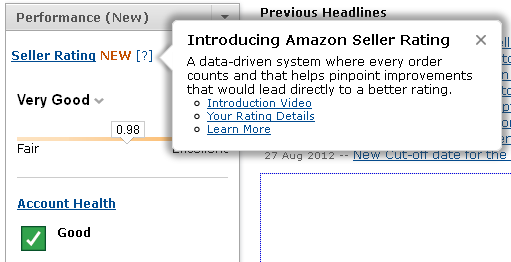 If you have this enabled you’ll know. There is a whopping great big pop-up message that appears on the Amazon dashboard after signing in. You’re given a rating and on a sliding scale of Fair to Excellent and in this example we can see this account is “Very Good”.
If you have this enabled you’ll know. There is a whopping great big pop-up message that appears on the Amazon dashboard after signing in. You’re given a rating and on a sliding scale of Fair to Excellent and in this example we can see this account is “Very Good”.
Note that this rating is appearing above the standard “Account Health” that you find in a normal Amazon Seller Central account, I am assuming this is because this is going to become the new standard for sellers to keep an eye upon.
An Introduction to Amazon Seller Ratings
This is the first video that is being used to inform Amazon Seller Central users about the new “Seller Ratings” and I’ve included the transcription under the video.
Press Play
This is the transcription of the video above and I’ve put the key parts in bold.
On Amazon, buyers have a lot of choices. So, when they are ready to purchase, what makes you stand out? Customers tell us that a sellers rating plays a critical part in their buying decision.
Would it not be great then if there is a rating system that could accurately reflect the effort you put in to making customers happy? Better still, what if the system could help you pin point customer service improvements that will lead directly to better rating and happier buyers?
Introducing Amazon seller rating inspired by and built for sellers. This unbiased, data driven system automatically recognizes your performance on every order. So now, every order counts towards and excellent, very good, good, or fair rating. This rating is based on how quickly you respond to buyers and whether you ship on time, cancel orders, have credit card charge backs, A to Z guarantee claims or negative feedback.
With this new seller rating system, buyers can get a complete picture of who they are trusting with their purchase and you can reap the rewards of all your hard work.
Seller ratings is not just comprehensive and objective; it also gives you more control. The seller matrix clearly points you to areas of improvement. Concentrate your rating on those and watch your rating and customer satisfaction rise. Simple as that!While we are very excited to release this new system to sellers, we have no immediate plans to make the ratings visible to buyers. This is because we really want your input first before we consider making it visible to buyers.
We also want to give you time to get familiar with your rating, understand how it is calculated and to make improvements.
At Amazon, we know how important building business is to you and we know how important happy customers are to your business. We are excited to introduce this new seller rating system that can help with both.To check out your rating and learn more, go to the seller rating page or click on the performance tab on seller central.
Seller Ratings Dashboard
To go with this new seller ratings, there is a new dashboard that is easy to understand. Although I have a suspicion that we’ll see this page evolve over time and likely see what we have on the Account health tab (the standard tab for monitoring performance on Amazon) join together into a single tab.
This dashboard is broken down into four key sections and before I walk you through them, it should be noted that all values shown in these images have been edited and may not add up correctly.
My Rating

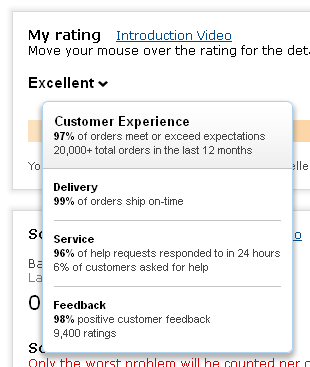 This block shows how you’re fairing and where you sit on the scale of “Fair” to “Excellent”. I didn’t notice this until later, but each of these ratings has a score assigned:
This block shows how you’re fairing and where you sit on the scale of “Fair” to “Excellent”. I didn’t notice this until later, but each of these ratings has a score assigned:
- Fair = 0 to 0.79
- Good = 0.8 to 0.93
- Very Good = 0.94-0.97
- Excellent = 0.98 to 1
We’ll be looking at these ratings in the next section, but for now realise that you’re being rated on a scale of 0 to 1 and you are being expected to perform in the top 0.3 percentile. Well, just like eBay :)
Score
There is a video on the rating system for which we’ll get to shortly, but for now we can see from the dashboard to the below that we (as sellers) are going to be given points. 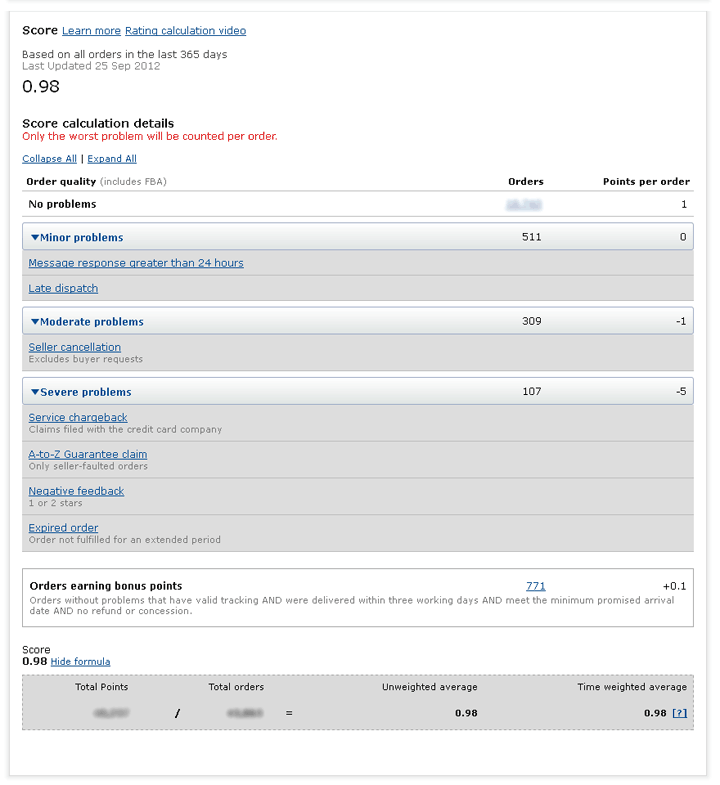 These points are broken up into 4 sections and there is a bonus too.
These points are broken up into 4 sections and there is a bonus too.
- No problems = 1 point
- Minor Problems = 0 points
- Moderate problems = -1 points
- Severe problems = -5 points
![]() +1 No problems
+1 No problems
If you have no issues with the order being processed and the customer receiving it ok etc… Then happy days we get a point, sweet!
![]() 0 Points for Minor Problems
0 Points for Minor Problems
But if you fail to answer an email within 24 hours, you wipe out the point you would have got for an order despatched on time and with no issues. The same goes if the order is late to be despatched.
![]() -1 Points
-1 Points
If you have to cancel the order, then I’m afraid this is where it starts to hurt, you receive a negative point for a cancelled order.
![]() – 5 Points for Being Bad
– 5 Points for Being Bad
Let’s face it the following four reasons are all bad and Amazon are going to slap you for a 5 points if you achieve any of these. Receiving a charge-back, an A-Z claim, a negative feedback or allowing an order to expire are all not nice to experience as a buyer, let a lone as a seller.
While I’m writing this I am reminded of a Ted.com video I watched a few weeks back. While I’m not going to include it here as part of the article (as it’s worthy of its very own), the dynamics being used in this system absolutely wreak gaming. The video which I’m taking about is here and it’s 10 minutes well spent.
![]() 0.1 Points as a Bonus
0.1 Points as a Bonus
If you get everything right then you’ll be awarded a 10% bonus, well 0.1 of a point for fulfilling your part of the process well, by including a valid tracking number, met the minimum proposed delivery date, had no refund and were delivered within 3 working days.  Assuming that most businesses include these details anyway, this could be an easy win.
Assuming that most businesses include these details anyway, this could be an easy win.
But it gets better, Amazon has also included a special note to a time weighted average. Something that we all know from eBay with Best Match and the value of recent sales.
Amazon’s calculation favours order history in the past 90 days but still keeps note of your past experience.
We’ll be looking0 at the points system next in a video from Amazon.
How are these Seller Ratings Calculated Video
Amazon’s gone the full hog with this and we’ve got a second video for the seller ratings. Again a full transcription of the video is included with the key points highlighted in bold.
Press Play
Video Transcription
At Amazon we know your rating is important to you and that it helps you build your business. So we want to help you understand how objective data is used to calculate your rating and how by focusing on specific improvement areas, you have the power to change it.
Here is how it works:
Every order is assigned a score. If an order is fulfilled without any problems, it gets one point. On the other hand, orders that have problems loose points.
These include orders that were canceled or expired, shipped late, had increased from buyers that took longer than 2 hours to respond to, had credit card charge backs, A to Z guarantee claims or negative feedback.
Some problems are more serious than others. So, for example, an order gets zero points if it’s shipped late but gets negative five points if it receives an A to Z guarantee claim. If an order has multiple problems, only the most serious one is counted.
You can also get bonus points. An order with truly exceptional service is awarded with an additional bonus of a 10th of a point for a total score of 1.1. Next, the score for all your orders within the last 12 months are totaled and an average is computed by dividing the total points by the number of orders.
Since performance on recent orders is more recent than those in the past, a time weighted average is applied to determine your final score.
Finally, depending on where your final score lies within the pre-determined range, you will be rated as a one of excellent, very good, good or fair. You can identify problem areas and then improve your rating by looking at the order quality report or by focusing on the suggestions on the seller rating page.
Some of you may discover that you do not have a rating. That just means you are a new seller or you have not had enough orders this year to calculate a rating. As your business grows and you have sufficient order history, the system will automatically calculate a rating for you. Meanwhile, you can still view your rating metrics to see how you are doing.
At Amazon, we are excited about a comprehensive and objective rating system that rewards you for all the effort you put in to your business and puts you in the driver seat.
How can I Improve My Rating
 This section shows the number of negative feedback, number of seller cancellations and late despatches, that in itself is useful, but what is sat behind this is even cooler and we’ll be looking at the new reporting tools in more depth shortly. Each of the suggestions, link to the same help page on Amazon here, but this may not work for you yet!
This section shows the number of negative feedback, number of seller cancellations and late despatches, that in itself is useful, but what is sat behind this is even cooler and we’ll be looking at the new reporting tools in more depth shortly. Each of the suggestions, link to the same help page on Amazon here, but this may not work for you yet!
Rating Trend
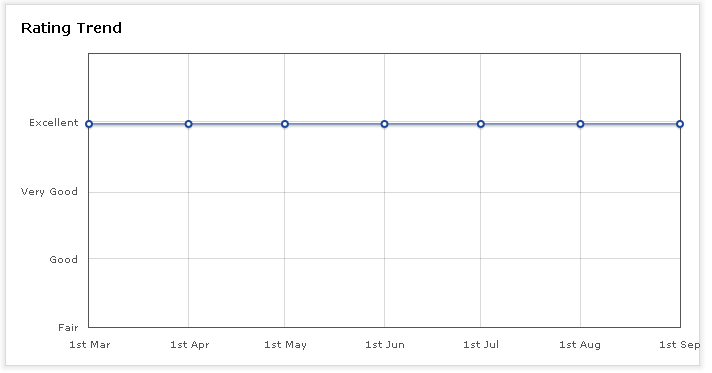 Decidedly un-remarkable currently, this chart over time will track your performance so you can see where your account is going. It gets better… honest.
Decidedly un-remarkable currently, this chart over time will track your performance so you can see where your account is going. It gets better… honest.
New Reporting!
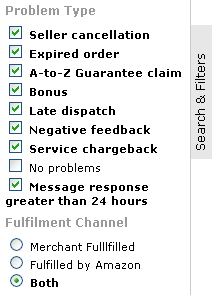 Transparency has been a big issues for sellers on eBay, especially for DSR ratings. Some sellers get reports and some do not. Finding out who has left you poor ratings is ni-on impossible for the masses and this is where Amazon have done really well. Their reporting for this new section is amazing.
Transparency has been a big issues for sellers on eBay, especially for DSR ratings. Some sellers get reports and some do not. Finding out who has left you poor ratings is ni-on impossible for the masses and this is where Amazon have done really well. Their reporting for this new section is amazing.
Well… that is if you spot the hidden side menu that allows you to filter the search results. But that is a tiny niggle. That side bar that says “Search & Filters” is not clear that it exist when you first load the page and I only spotted it by accident.
On opening you can see in the screen shot, there are numerous search filters and also a date range filter that I’ve not included in the screen shot too. But thats just the filters, you wait till you see the report below!
The screen shot below shows an edited version of a orders report.
I’ve put a huge TICK next to the tick box you want to click on as again this is a hidden feature that shows all the good stuff in the report.
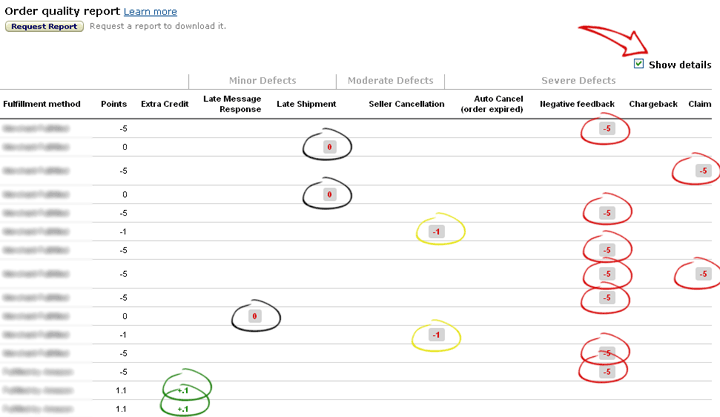 In the report above I have used a couple of colours to indicated the different scores in action. For orders where there has been a screw up, then -5 points have been applied, there are a few -1’s and a few 0’s as well.
In the report above I have used a couple of colours to indicated the different scores in action. For orders where there has been a screw up, then -5 points have been applied, there are a few -1’s and a few 0’s as well.
What is shown is that there are two 1.1 transactions and while this report gives a good overview of the scores in action, the filters used were to show the the zero and negative values and the vast majority of your account should be +1 and +1.1’s.
Amazon Seller Ratings Summary
Technically we already get the stats for the products rankings on Amazon through the seller reports and sales rank scores. Amazon have now made the variables that they see as important to buyers, ensuring that the customer is happy is now rewarded.
But when the customer is not kept happy, then they’ll slap you & take points away from you. No one likes anything being removed, taken away or deducted and if they play the gaming dynamics on this well, this should see some interesting results given enough time.
Talking of gaming dynamics, here is one for Mr Bezos, making the seller stats public, as much as they’d hate you for it (I’m sure a few of you just gasped at that), would make a massive game that pitches product based businesses against each other on a open(ish) playing field other than just the price race to the bottom.
The video content included by Amazon is excellent and in the video for the how the ratings are calculated, it’s mentioned that the ratings are not going to be shown to the buyers just yet.
I’m not sure that 0.98 really means a lot to buyers. The general public understands percentages a lot more easily and my biggest comment to Amazon is to that convert this number to a percentage and show that to a buyer instead. 0.98 means what exactly? “Is that not even 1 out of a hundred?” You see my point?
Along with keeping it clear to buyers, Amazon has so far kept a clean interface, but even while I believe that the have included is very cool, looks fab and it’s been explained well, I do have my reservations that this may confuse business owners, especially new businesses to Amazon with new seller ratings, if they’re not combined with the existing options quickly.
What do you think?
Do you like the idea of a points mechanism, where you are rewarded for good behaviour and slapped for being bad? Do you think this is a good idea or a bad idea?
Let me know in the comments box below.

